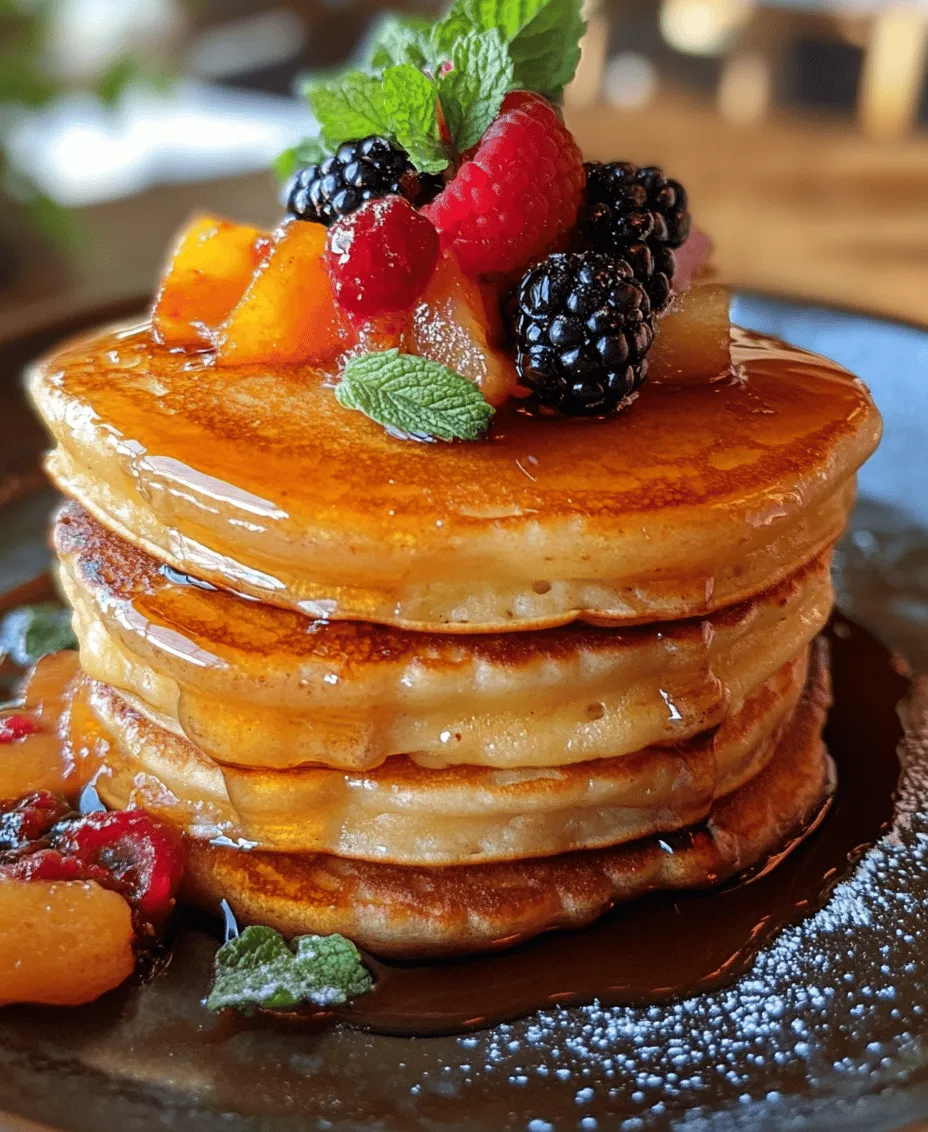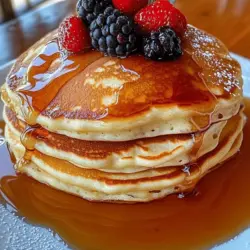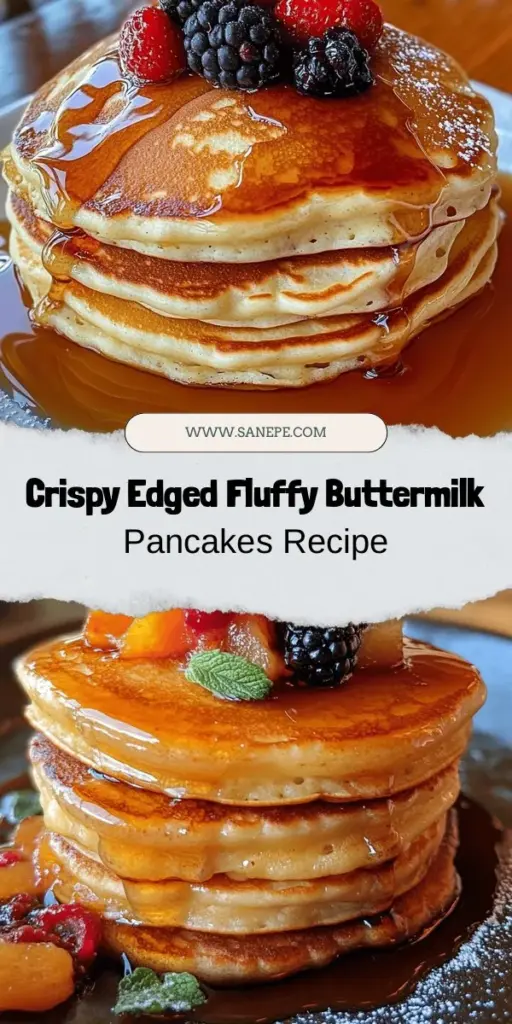Introduction to Fluffy Buttermilk Pancakes with Crispy Edges
When it comes to breakfast, few dishes can rival the comforting allure of pancakes. Fluffy buttermilk pancakes, in particular, have carved a special place in the hearts of breakfast lovers everywhere. Their light and airy texture, combined with those perfectly crispy edges, makes them a staple on breakfast tables. Whether you’re enjoying them with a drizzle of maple syrup, a dollop of whipped cream, or a handful of fresh berries, these pancakes promise to be a delightful start to your day.
What sets buttermilk pancakes apart from traditional pancakes is not just their texture, but also their unique flavor profile. The addition of buttermilk introduces a subtle tanginess that balances beautifully with the sweetness of syrup or fruit toppings. Furthermore, the use of quality ingredients is crucial in achieving the ideal flavor and texture. Fresh buttermilk, high-quality flour, and pure vanilla extract can elevate your pancakes from good to extraordinary, making a noticeable difference in your final dish.
The Science Behind Fluffy Pancakes
Understanding the science behind fluffy pancakes can significantly enhance your cooking skills. One of the key players in creating that coveted fluffiness is buttermilk. This slightly acidic dairy product reacts with baking soda, a common leavening agent, to produce carbon dioxide bubbles as the batter cooks. These bubbles expand, creating the light, airy structure that defines a great pancake. Buttermilk also adds moisture to the batter, which contributes to a tender finish.
In addition to buttermilk, baking powder and baking soda work in tandem to provide lift. Baking powder contains both an acid and a base, which means it can create leavening on its own when mixed with wet ingredients. Baking soda, on the other hand, requires an acidic ingredient (like buttermilk) to activate. This dual-action leavening ensures that your pancakes are not only fluffy but also rise beautifully on the griddle.
Another crucial factor in achieving perfect pancakes is allowing the batter to rest. When you mix the ingredients, gluten forms in the flour. By letting the batter sit for about 10-15 minutes, you allow the gluten to relax, which results in a more tender pancake. During this resting period, the leavening agents also have time to start working, creating an even fluffier texture when cooked.
Essential Ingredients for the Perfect Pancake
To create the fluffiest buttermilk pancakes with crispy edges, each ingredient plays a specific role that contributes to the overall quality of the dish. Here’s a breakdown of the essential components:
All-Purpose Flour
All-purpose flour is the foundation of your pancake batter. It provides the necessary structure and texture. For the best results, use a high-quality flour that has a moderate protein content. This balance allows for the perfect combination of tenderness and structure.
Granulated Sugar
Granulated sugar serves two purposes in pancake batter: it adds sweetness and helps achieve that beautiful caramelization on the edges. As the pancakes cook, the sugar caramelizes, creating a slight crispiness that contrasts with the fluffy interior.
Baking Powder and Baking Soda
These leavening agents are crucial for creating lift in your pancakes. Baking powder helps the batter rise quickly, giving it that light and fluffy texture, while baking soda works with the acidity of the buttermilk to produce even more bubbles. The combination of both ensures that your pancakes achieve the perfect height and lightness.
Salt
Salt is often overlooked, but it plays a vital role in enhancing the overall flavor of your pancakes. It helps to balance the sweetness and brings out the other flavors in the batter.
Buttermilk
As mentioned earlier, buttermilk is the star ingredient in this recipe. Its acidity not only contributes to the fluffiness of the pancakes but also adds a distinctive tang that elevates the flavor profile. The moisture content in buttermilk prevents the pancakes from becoming dry.
Egg
The egg is a binding agent that helps hold the pancake batter together. It also contributes richness and adds to the overall flavor. Using a room temperature egg ensures better incorporation into the batter.
Unsalted Butter
Unsalted butter adds flavor and serves as a cooking medium for the pancakes. Using unsalted butter allows you to control the saltiness of the batter, ensuring that your pancakes are perfectly seasoned.
Vanilla Extract
While vanilla extract is optional, it can be a wonderful addition to your pancake batter. It imparts a lovely aroma and a hint of sweetness, enhancing the overall flavor of the pancakes.
Step-by-Step Guide to Making Fluffy Buttermilk Pancakes
Now that we’ve covered the essential ingredients and the science behind making fluffy buttermilk pancakes, let’s dive into the detailed step-by-step instructions for preparing this delightful breakfast. Follow these steps to achieve pancake perfection:
Step 1: Gather Your Ingredients
Before you start cooking, gather all the necessary ingredients and measuring tools. This will help streamline the cooking process and ensure you don’t miss anything. You’ll need:
– 1 cup all-purpose flour
– 2 tablespoons granulated sugar
– 1 teaspoon baking powder
– 1/2 teaspoon baking soda
– 1/4 teaspoon salt
– 1 cup buttermilk
– 1 large egg
– 2 tablespoons unsalted butter, melted
– 1 teaspoon vanilla extract (optional)
Step 2: Mix Dry Ingredients
In a large mixing bowl, combine the all-purpose flour, granulated sugar, baking powder, baking soda, and salt. Whisk these dry ingredients together until they are well blended. This step is crucial, as it ensures even distribution of the leavening agents and sugar throughout the batter.
Step 3: Combine Wet Ingredients
In a separate bowl, whisk together the buttermilk, egg, melted butter, and vanilla extract (if using). Make sure the melted butter is not too hot, as you don’t want to cook the egg when mixing. Whisk until the mixture is smooth and well combined.
Step 4: Combine Wet and Dry Mixtures
Make a well in the center of the dry ingredients and pour in the wet mixture. Using a spatula or a wooden spoon, gently fold the wet ingredients into the dry ingredients. Be careful not to overmix; a few lumps are perfectly fine. Overmixing can lead to tough pancakes due to the development of gluten.
Step 5: Let the Batter Rest
Once the batter is mixed, let it rest for about 10-15 minutes. This resting period allows the gluten to relax and lets the leavening agents begin their work, ensuring your pancakes will be as fluffy as possible.
Step 6: Prepare the Cooking Surface
While the batter is resting, preheat your griddle or non-stick skillet over medium heat. To check if it’s ready, sprinkle a few drops of water on the surface; if they sizzle and evaporate immediately, your pan is hot enough. Lightly grease the cooking surface with a small amount of unsalted butter or cooking spray.
Step 7: Cook the Pancakes
Once your cooking surface is prepared, pour about 1/4 cup of batter onto the griddle for each pancake. Leave enough space between each pancake to allow for spreading. Cook the pancakes for about 2-3 minutes on one side, or until you see bubbles forming on the surface and the edges look set. Flip the pancakes carefully with a spatula and cook for an additional 1-2 minutes on the other side, or until golden brown and cooked through.
Following these steps will set you on the right path to creating the most delightful fluffy buttermilk pancakes with crispy edges. Enjoy the process and get ready to savor a breakfast classic!

Mixing Dry Ingredients: Importance of Even Distribution
To achieve the perfect fluffy buttermilk pancakes, the first step is to mix your dry ingredients properly. This typically includes all-purpose flour, baking powder, baking soda, sugar, and a pinch of salt. The reason even distribution of these ingredients is crucial lies in their individual roles: baking powder and baking soda act as leavening agents, while sugar adds sweetness and salt enhances flavor. If these components are not evenly mixed, you may end up with pancakes that are unevenly risen or have pockets of saltiness.
To ensure an even blend, whisk the dry ingredients together in a large bowl until they are well combined. This step not only aerates the flour but also eliminates any potential clumps, setting a strong foundation for your pancake batter.
Combining Wet Ingredients: Achieving the Right Consistency
Once your dry ingredients are thoroughly mixed, it’s time to focus on the wet ingredients. In this recipe, you’ll typically need buttermilk, eggs, and melted butter. The key here is to whisk these ingredients together in a separate bowl until they are fully combined.
Achieving the right consistency is essential. The buttermilk provides that signature tang and moisture, while the eggs contribute to the structure and richness of the pancakes. If your wet mixture is too thick, your pancakes will be dense; too thin, and they’ll spread too much on the skillet. Ideally, the consistency should be smooth and pourable, resembling a thick cream.
The Significance of Gentle Mixing to Avoid Dense Pancakes
Once you have combined your wet and dry ingredients, it’s crucial to mix them together gently. Overmixing can lead to gluten development in the flour, resulting in tough, dense pancakes instead of the light, airy texture we all crave.
To avoid this, add the wet mixture to the dry ingredients and use a rubber spatula or wooden spoon to fold them together. Mix just until you see no more dry flour; it’s okay if there are a few small lumps. Remember, some lumps are perfectly normal and will help keep your pancakes light and fluffy.
The Resting Period: How It Affects Moisture and Fluffiness
After mixing, let your pancake batter rest for about 10 to 15 minutes. This resting period is not just a waiting game; it’s a crucial step to achieving maximum fluffiness. During this time, the flour absorbs the liquid from the buttermilk, which hydrates the batter and allows the leavening agents to start working.
Additionally, resting allows the gluten to relax, which helps create a tender pancake. The result? Pancakes that are not only fluffy but also moist and deliciously satisfying.
Cooking Techniques for Perfect Pancakes
Choosing the Right Cookware: Benefits of Non-Stick Skillets and Griddles
When it comes to cooking your pancakes, the choice of cookware can significantly impact the outcome. A non-stick skillet or griddle is ideal because it helps prevent the pancakes from sticking, allowing for easy flipping and minimal mess.
If you don’t have non-stick cookware, you can use a regular skillet, but ensure you grease it adequately with butter or oil before adding your batter. This will help prevent sticking and provide that desirable crispy edge.
Ideal Temperature for Cooking Pancakes: Tips for Maintaining Consistent Heat
Temperature control is vital for perfect pancakes. If your pan is too hot, the outside will cook too quickly, leaving the inside undercooked. Conversely, if it’s not hot enough, your pancakes will turn out pale and flat.
Preheat your skillet over medium heat. To test if it’s ready, sprinkle a few drops of water on the surface; if they sizzle and evaporate quickly, your skillet is at the perfect temperature. Additionally, you can take a small amount of batter and pour it onto the skillet. If it bubbles and starts to set around the edges after a few seconds, you’re good to go!
How to Tell When Pancakes Are Ready to Flip: Visual Cues and Timing
Knowing when to flip your pancakes can be tricky, but there are a few key visual cues. Watch for bubbles forming on the surface of the pancake; when they start to pop and the edges appear set, it’s time to flip. This usually takes about 2 to 3 minutes on the first side.
When flipping, use a spatula to gently lift the pancake and turn it over. The second side usually cooks faster, generally taking about 1 to 2 minutes. You’ll know it’s done when the pancake is golden brown and springs back when lightly pressed.
Techniques for Achieving Crispy Edges: Cooking Time and Butter Application
To achieve those iconic crispy edges, you can apply a little melted butter around the edges of each pancake after pouring the batter onto the skillet. This technique not only enhances flavor but also contributes to that delightful texture.
Cook your pancakes for a longer time on the first side, allowing them to form a nice crust before flipping. This method yields pancakes that are perfectly crispy on the outside while remaining fluffy on the inside.
Serving Suggestions for Buttermilk Pancakes
Traditional Toppings: Maple Syrup and Fresh Berries
Once your pancakes are cooked to perfection, it’s time to serve them up! Traditional toppings like warm maple syrup and a handful of fresh berries are always a hit. The sweetness of the syrup complements the tanginess of the buttermilk, while the berries add a refreshing burst of flavor and a pop of color.
Creative Variations: Adding Chocolate Chips, Nuts, or Fruit to the Batter
For a fun twist on the classic recipe, consider adding chocolate chips, nuts, or fruit directly to the batter. Chocolate chips melt beautifully, creating gooey pockets of sweetness. Walnuts or pecans add a delightful crunch, and fresh fruit like bananas or blueberries can elevate your pancakes to a whole new level of deliciousness.
Pairing Pancakes with Side Dishes: Eggs, Bacon, or Yogurt for a Complete Breakfast
To make your breakfast even more satisfying, consider pairing your fluffy buttermilk pancakes with side dishes like scrambled eggs, crispy bacon, or a dollop of yogurt. These additions not only create a complete meal but also balance out the sweetness of the pancakes, making for a well-rounded breakfast experience.
Nutritional Information and Benefits of Buttermilk Pancakes
Overview of Calorie Count and Nutritional Breakdown per Serving
When enjoyed in moderation, buttermilk pancakes can be a delightful addition to your breakfast menu. A typical serving of two pancakes (without toppings) contains approximately 350 calories, 8 grams of protein, 14 grams of fat, and 50 grams of carbohydrates. The exact nutritional breakdown may vary depending on specific ingredients and portion sizes.
Discussion of the Health Aspects of Using Buttermilk Versus Regular Milk
Using buttermilk instead of regular milk has its benefits. Buttermilk is lower in calories and fat, yet it provides a rich, tangy flavor that enhances the pancakes. Moreover, buttermilk contains probiotics, which can aid in digestion. This makes it a healthier alternative that contributes to both taste and well-being.
Potential Modifications for Healthier Options, Such as Whole Wheat Flour or Alternative Sweeteners
If you’re looking to make your pancakes a bit healthier, consider substituting half of the all-purpose flour with whole wheat flour. This increases fiber content and enhances the nutritional profile. Additionally, you can reduce the amount of sugar or use alternative sweeteners like honey or maple syrup. For a lighter option, try using egg whites instead of whole eggs or incorporating mashed bananas into the batter for natural sweetness.
Conclusion: Enjoying Your Fluffy Buttermilk Pancakes
There’s something inherently joyful about making fluffy buttermilk pancakes at home. The aroma that fills your kitchen as they cook, the anticipation of flipping them perfectly, and the satisfaction of enjoying a warm stack topped with your favorite ingredients all contribute to a delightful breakfast experience.
These pancakes are not only simple to make but also incredibly versatile. Don’t hesitate to experiment with various toppings and mix-ins to create your perfect pancake masterpiece. The comfort and nostalgia associated with homemade pancakes are timeless, making them a beloved staple in kitchens around the world.
So gather your ingredients, follow these steps, and enjoy the deliciousness that is homemade fluffy buttermilk pancakes. They are sure to become a cherished part of your breakfast repertoire, bringing smiles to the table for years to come.


